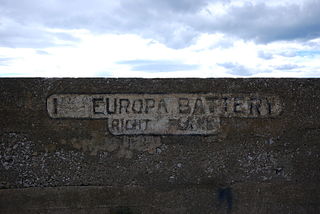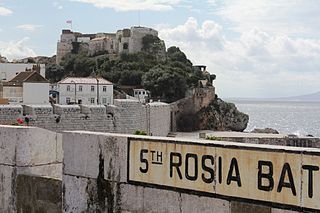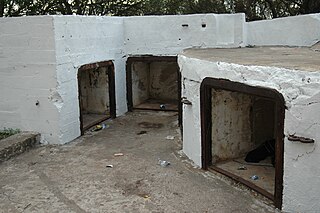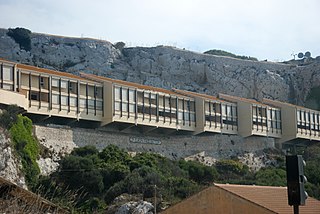Related Research Articles

Couvreport Battery is an artillery battery in the British Overseas Territory of Gibraltar.

The Europa Batteries are a group of artillery batteries in the British Overseas Territory of Gibraltar. Facing the North African coast, they are the most southerly batteries in Gibraltar and were built to cover ships approaching from the Mediterranean Sea. They run along the fortified clifftops of Europa Point from Camp Bay on the west side of the Rock of Gibraltar to the Europa Advance Batteries on the east side.

Grand Battery is an artillery battery in the British Overseas Territory of Gibraltar. To the west of the grand battery was a very formidable flank which was considered to have been a "great annoyance to the besiegers."

Hayne's Cave Battery is the remains of two gun positions that made up an artillery battery on the west side of the British Overseas Territory of Gibraltar at Hayne's Cave. Gun emplacements can still be visited at this cave.
Jones' Battery is one of the best preserved of the "retired" artillery battery in the British Overseas Territory of Gibraltar. It was named after Sir John Thomas Jones who once controlled the fortifications here.

King's Lines Battery is an artillery battery in the British Overseas Territory of Gibraltar. It was originally built along the access path up to the Gate of Granada.

The Rosia Batteries are a group of artillery batteries in the British Overseas Territory of Gibraltar.

Tovey Battery was an artillery battery in the British Overseas Territory of Gibraltar.

Saluting Battery was an artillery battery in the British Overseas Territory of Gibraltar.

Europa Pass Batteries are a group of artillery batteries in the British Overseas Territory of Gibraltar. They are located north west of Europa Point in the south of Gibraltar, just off Europa Road.

Castle Batteries are a series of artillery batteries that are part of the Northern Defences of the British Overseas Territory of Gibraltar. The batteries descend from the Moorish Castle to end at the sixth and seven batteries which are known as Crutchett's Batteries. There are brick vaulted bombproof rooms (casemates) under Crutchets Battery.
Civil Hospital Battery was an artillery battery in the British Overseas Territory of Gibraltar.
Cumberland Flank Battery was an artillery battery in the British Overseas Territory of Gibraltar.
Devil's Bowling Green Battery was an artillery battery in the British Overseas Territory of Gibraltar. In 1859, the battery had two guns that looked over Little Bay. This battery was on the shoreline but it was overlooked by the Buena Vista Battery and the seven guns of the Europa Pass Batteries.
Eliott's Battery was an artillery battery in the British Overseas Territory of Gibraltar. The battery is located in front of the Officer's Barracks at Europa Flats between Prince George's Battery and Woodford's Battery. The battery is named after George Augustus Eliott, 1st Baron Heathfield, Governor of Gibraltar 1777–1790.
Hutment Battery is an artillery battery in the British Overseas Territory of Gibraltar. The battery got its name from its proximity the military hutment area near Bleak House. In 1878, the battery mounted an RML 12.5-inch 38-ton gun.
Lady Augusta's Battery was an artillery battery in the British Overseas Territory of Gibraltar.
Prince of Wales Battery is an artillery battery in the British Overseas Territory of Gibraltar.
South Batteries is an artillery battery in the British Overseas Territory of Gibraltar.
Woodford's Battery was an artillery battery in the British Overseas Territory of Gibraltar. It is located at Europa Flats between the Defensible Barracks and the Officer's Barracks and Eliott's Battery.
References
- ↑ Fa & Finlayson (2006). The Fortifications of Gibraltar 1068–1945. Osprey Publishing. ISBN 978-1-84603-016-1 . Retrieved 4 April 2013.